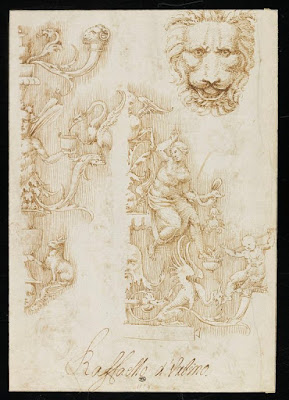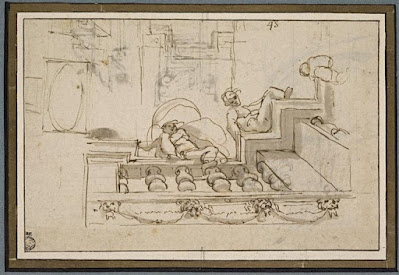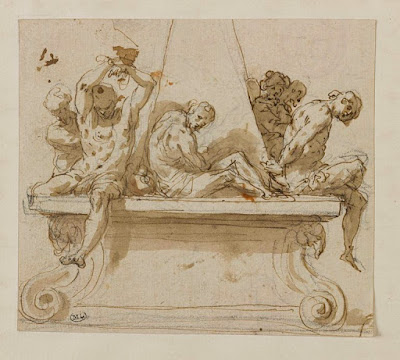 |
| Giovanni Maria Falconetto Design for Funerary Monument before 1535 drawing, with gouache (based on antique elements) Musée du Louvre |
 |
| follower of Amico Aspertini Sheet of Decorative Studies ca. 1530-50 drawing Musée du Louvre |
 |
| Francesco Maria da Cornazzano (il Zoppino) Ornamental Scheme with Young Woman helping a Hermit climb out of a Fissure ca. 1530-45 drawing (study for fresco) Musée du Louvre |
 |
| Antonio Campi Fragment of Design for a Triumphal Arch for the Entry of Charles V into Cremona 1541 drawing Musée du Louvre |
 |
| Antonio Campi Fragment of Design for a Triumphal Arch for the Entry of Charles V into Cremona 1541 drawing Musée du Louvre |
 |
| Nicolò dell'Abate Design for a Monumental Clock 1550 drawing Musée du Louvre |
 |
| Giulio Camillo dell'Abate Study for La Porte aux Peintres at the Château de Fontainebleau ca. 1568-71 drawing Nationalmuseum, Stockholm |
 |
| Raffaellino da Reggio (Raffaele Motta) Design for a Fountain before 1578 drawing Musée du Louvre |
 |
| Giovanni Alberti Scheme for Wall Decoration at Palazzo Ruggieri Serafini, Rome 1591 drawing Musée du Louvre |
 |
| Annibale Carracci Ignudi on Cornice ca. 1597-1602 drawing (study for vault fresco, Galleria Farnese, Rome) Musée du Louvre |
 |
| Pellegrino Tibaldi Design for a Decorative Frieze before 1596 drawing Musée du Louvre |
 |
| follower of Pellegrino Tibaldi Ornamental Design with Satyrs and Masks ca. 1575-1600 drawing Musée du Louvre |
 |
| Paolo Farinati Corner Element of Ceiling Decoration before 1606 drawing (study for a palace in Verona) Musée du Louvre |
 |
| Paolo Farinati Design for a Fireplace before 1606 drawing Musée du Louvre |
 |
| attributed to Giovanni Lanfranco Ceiling Design for the Villa Borghese, Rome ca. 1624-25 drawing, with watercolor Musée du Louvre |
 |
| attributed to Palma il Giovane Study of Captives for a Victory Monument before 1628 drawing Musée du Louvre |
"We are told by Pliny that all the statues before the time of Daedalus were represented stiff and motionless with winking eyes, closed feet, and arms hanging in right lines to their sides. These were the rude essays of design. Daedalus and his immediate followers unfolded these embarrassed figures; they threw motion into the limbs, and life into the countenance. In the progress of the arts, and in able hands, motion was fashioned into grace, and life was heightened by character. Now, too, it was that beauty of form was no longer confined to mere imitation, which always falls short of the object imitated; to make the copy equal in its effect, it was necessary to give it some advantage over its model. The artist, therefore, observing that nature was sparing of her perfections, and that her efforts were limited to parts, availed himself of her inequality, and drawing these scattered beauties into a more happy and compleat union, rose from an imperfect imitative, to a perfect ideal beauty."
– Daniel Webb, from Of Design, published in An Inquiry into the Beauties of Painting and into the Merits of the most Celebrated Painters, Ancient and Modern (1760)